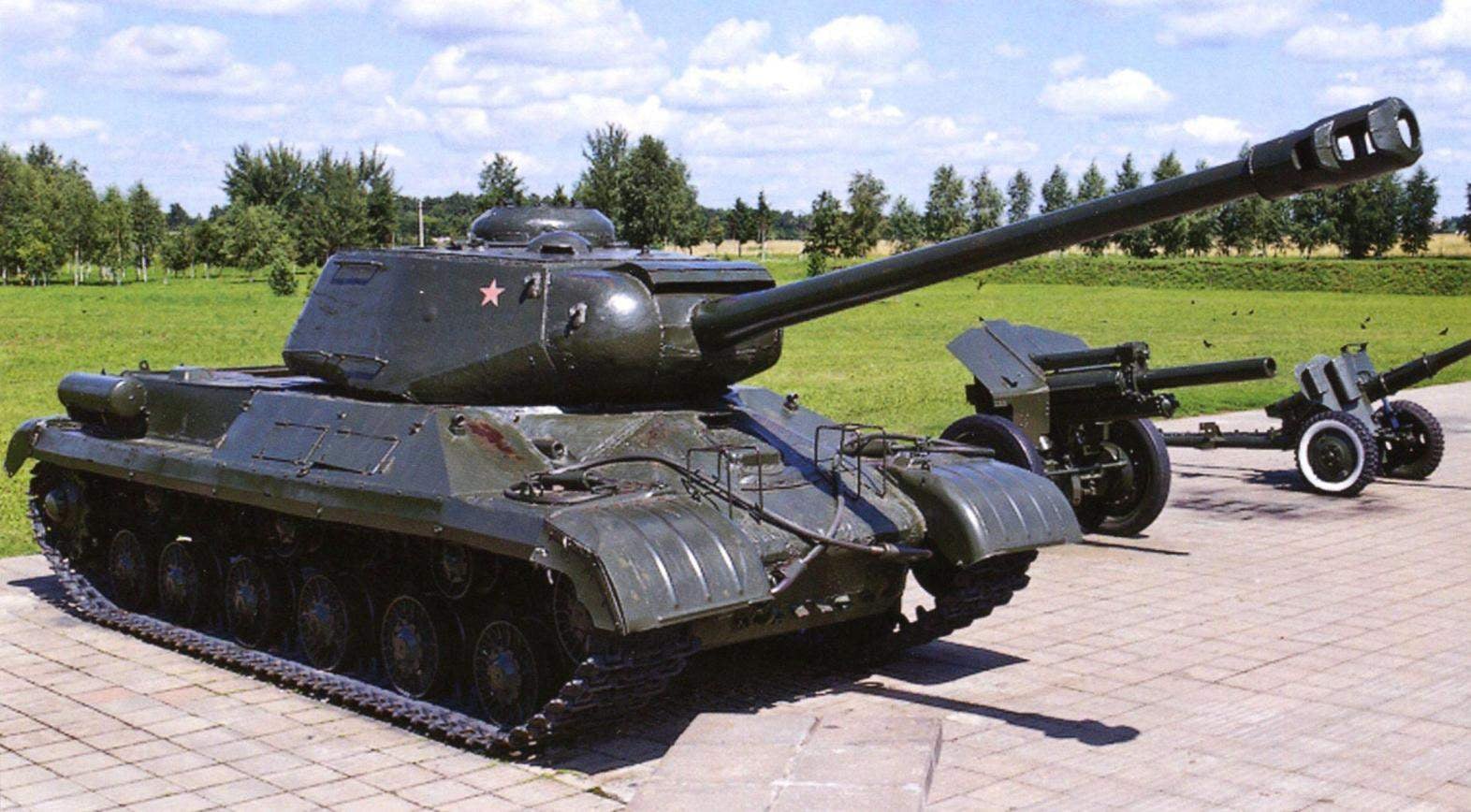The fuel system consisted of two tanks with a volume of 180 liters and 245 liters, which were on the sides of the hull in the Department of management. Lubrication system -circulating, under pressure – had two tank 160 l, placed at the engine.
Transmission of the tank – mechanical. It was a multi-plate main clutch, which had steel and iron friction wheels, gearbox with movable couplings, friction clutches dry friction of steel on steel. Single-stage planetary final drives were mounted directly on the brackets of the drive wheels. Transmission – devyatikonechnoy: eight forward gears and one backward.
The brakes were set floating belt, with plates of iron.
KV-13 weight 32,4 t had a powerful frontal hull armor up to 120 mm tower-to 85 mm, but had the mobility on the battlefield is not worse than the average tank T-34
The forehead of the KV-13. On the turret right of the gun is visible, the recess coupled 76.2-mm machine gun DT, under the tower – the viewing driver’s hatch with inset “triplex”
Feed tank the KV-13. The upper aft armor plate was removable but had two hatches with pokryshki to access the transmission. Aft of the tower – closed with plugs the loopholes for firing personal weapons of the crew
The electrical equipment received voltage 24 V engine running from generator GT-6543-a, And in the Parking lots, from four batteries, SCTE-80.
The engine compartment of the tank was separated from military armored wall. Above it is attached to the roof, consisting of medium bronelista and two hinged side providing access to the engine, oil tanks and air cleaners, as well as armor box blinds. It had three exhaust ports to output exhaust gases of the engine. The upper aft armor plate was removable but had two hatches with pokryshki to access the transmission.
So looked and were arranged in a tank project of KV-13 (“object 233”) “enhanced” booking for February, 1943 J. Kotin in a memo to the leadership of the people’s Commissariat noted: “Practically solved a question on the creation of securely booked against all types of anti-tank artillery tank, which will have mobility on the battlefield is not worse than the average tank T-34”.
Reservation scheme of the KV-13
Tank KV-13 in the court of the Chelyabinsk plant No. 100. March, 1943
“A sample of 234”, armed with a 122 mm howitzer U-11, and “sample 233” 76.2-mm gun ZIS-5 in the Chelyabinsk Kirov factory. Future tanks IP-2 and IP-1
However, the events at the front forced in another way to dispose of the fate of the tank “Klim Voroshilov” – KV-13. In August 1942, the station mga near Leningrad for the first time in the fighting was attended by the German heavy tanks “Tiger”. Their 88-mm gun capacity surpassed our 76-mm, then stood on the T-34.
Military historians note that soon after in the defense industry, the question was raised about the early modernization of tanks KV-13. On 24 February 1943 the State Defense Committee adopted Resolution No. 2943сс about “prototypes of heavy tanks”, which were ordered in a short time to bring to the test two experimental tank “Joseph Stalin”. To satisfy the requirements and took the fabricated samples KV-13. One of them put a 76.2-mm gun ZIS-5 and was designated as EC-1, leaving the same – “object 233”. The other is-2 “object 234” – armed with 122-mm howitzer U-11 in the turret of the heavy tank KV-9.
In March – April of the same year conducted their tests, after which the Commission, consisting of military specialists and representatives of defence industry, concluded that “tanks are with less mass stronger bookings and higher speed” than the heavy KV-1, with equal arms with him, as in IP-1, or more powerful as the is-2.
The way before the heirs of the KV-13 was opened.
PERFORMANCE CHARACTERISTICS OF A MEDIUM TANK KV-13
Combat weight, kg…………………32 400
Crew………………………………..3
Length with gun forward, mm…..6650
Width, mm…………………………..2800
Height, mm……………………………2500
Ground clearance, mm……………………………450
Booking, mm:
-forehead………………………………80-120
– side…………………………….75 – 85
– feed…………………………….60 – 85
– the bottom……………………………20 – 30
– roof…………………………………..20
The tower, mm:
– forehead……………………………………….85
– side……………………………………85
– feed……………………………………85
– roof…………………………………..20
… Armament 76.2 mm gun ZIS-5,
7.62-mm machine gun DT-29
Ammunition……….. shots 57-65,
7.62-mm cartridges – 945
Sights…….telescopic DT-7,
periscope PT-4-7
Engine……………12-cylinder
diesel
IN-2K
liquid-cooled, 600 horsepower
The volume of fuel tanks, l………425
Reserve, km………………………..320
Speed on highway, km/h……………65
Overcoming obstacles in m:
– the height of the wall………………………1,0
– the width of the pit………………………..2,20
– fording depth…………………….1,30
Radio…….high
10P
Tools
internal communication………….TPU-3-bis
 In December 1941, the design Bureau of Chelyabinsk Kirov factory (up to October 1941 – Chelyabinsk tractor plant) representatives of the Armored Directorate of the red Army considered the draft design of the new tank “Klim Voroshilov” – KV-13 — “high-speed tank enhanced reservation”. According to the designers, it’s time to create a “single tank”, who would be able to combine all the positive characteristics of serial KV and T-34. The fact that KV was very difficult to manufacture, “not enough technologically advanced and not suitable to mass production in wartime”. They had surpassed the T-34 but more powerful armor.
In December 1941, the design Bureau of Chelyabinsk Kirov factory (up to October 1941 – Chelyabinsk tractor plant) representatives of the Armored Directorate of the red Army considered the draft design of the new tank “Klim Voroshilov” – KV-13 — “high-speed tank enhanced reservation”. According to the designers, it’s time to create a “single tank”, who would be able to combine all the positive characteristics of serial KV and T-34. The fact that KV was very difficult to manufacture, “not enough technologically advanced and not suitable to mass production in wartime”. They had surpassed the T-34 but more powerful armor.